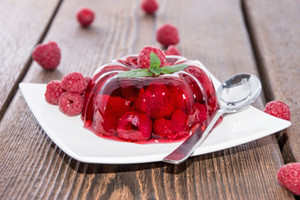Agar (pronounced /ˈeɪɡɑː/, US /ˈɑːɡər/, “ah-gər“) or agar-agar (/ˈeɪɡɑːˈeɪɡɑː/, /ˈɑːɡərˈɑːɡər/, “ah-gər-ah-gər“) is a jelly-like substance, obtained from algae. It was discovered in the late 1650s or early 1660s in Japan.
Contents
Uses
- Agar-agar is a natural vegetable gelatin counterpart. White and semi-translucent, it is sold in packages as washed and dried strips or in powdered form. It can be used to make jellies, puddings, and custards.
- Agar-agar is approximately 80% fiber ,so it can serve as an intestinal regulator. Its bulk quality is behind one of the latest fad diets in Asia, the kanten (the Japanese word for agar-agar) diet. Once ingested, kanten triples in size and absorbs water. This results in the consumers feeling fuller. This diet has recently received some press coverage in the United States as well. The diet has shown promise in obesity studies.
- One use of agar in Japanese cuisine (Wagashi) is anmitsu, a dessert made of small cubes of agar jelly and served in a bowl with various fruits or other ingredients. It is also the main ingredient in mizu yōkan, another popular Japanese food.
- In Philippine cuisine, it is used to make the jelly bars in the various gulaman refreshments or desserts such as sago gulaman,buko pandan, agar flan, halo-halo, and the black and red gulaman used in various fruit salads.
- In Russia, it is used in addition or as a replacement to pectin in jams and marmalades, as a substitute to gelatin for its superior gelling properties, and as a strengthening ingredient in souffles and custards. Another use of agar-agar is in ptich’ye moloko(bird’s milk), a rich jellified custard (or soft meringue) used as a cake filling or chocolate-glazed as individual sweets. Agar-agar may also be used as the gelling agent in gel clarification, a culinary technique used to clarify stocks, sauces, and other liquids.
- Mexico has traditional candies made out of Agar gelatin, most of them in colorful, half-circle shapes that resemble a melon or watermelon fruit slice, and commonly covered with sugar. They are known in Spanish as Dulce de Agar (Agar sweets)
Agar-agar is an allowed nonorganic/nonsynthetic additive used as a thickener, gelling agent, texturizer, moisturizer, emulsifier, flavor enhancer, and absorbent in certified organic foods
-
- As an impression material in dentistry.
- To make salt bridges and gel plugs for use in electrochemistry.
- In formicariums as a transparent substitute for sand and a source of nutrition.
- As a natural ingredient to form modelling clay for young children to play with.
- As an allowed biofertilizer component in organic farming.
Gelidium agar is used primarily for bacteriological plates. Gracilaria agar is used mainly in food applications.
Benefits
- Agar is 80% fiber, contains no fat, no protein, and only a small amount of carbohydrates. Ten grams, or two tablespoons, of agar contains only three calories, derived from its small amount of carbohydrates. Due to agar’s high levels of fiber, agar is sometimes used as a dietary aid to promote fullness or as a laxative. Agar also contains a small amount of iodine and other trace minerals.
Cautions
- Agar is POSSIBLY SAFE for most adults when taken by mouth with at least one 8-ounce glass of water. If it is not taken with enough water, agar can swell and block theesophagus or bowel. Immediate medical attention is necessary if chest pain, vomiting, or difficulty swallowing or breathing occurs after taking agar. In some people, agar may also raise cholesterol.
Interactions
Medications taken by mouth (Oral drugs) interacts with AGAR
Agar is a thick gel. Agar might stick to some medications in the stomach and intestines. Taking agar at the same time as medications that you take by mouth might decrease how much medication your body absorbs, and possibly decrease the effectiveness of your medication. To prevent this interaction, take agar at least one hour after medications you take by mouth.
Other names
Agar-Agar, Agarose, Agarose Gel, Agaropectin, Agarweed, Algue de Java, Chinese Gelatin, Colle du Japon, Garacilaria confervoides, Gélatine de Chine, Gelidiella acerosa, Gelidium amanasii, Gelidium cartilagineum, Gelidium crinale, Gelidium divaricatum, Gelidium pacificum, Gelidium vagum, Gelosa, Gelosae, Gélose, Japanese Isinglas, Kanten Diet, Kanten Jelly, Kanten Plan, Layor Carang, Mousse de Ceylan, Mousse de Jaffna, Qion Zhi, Seaweed Gelatin, Vegetable Gelatin, Vegetarian Gelatin
References
Source: Wikipedia, https://en.wikipedia.org/wiki/Agar

